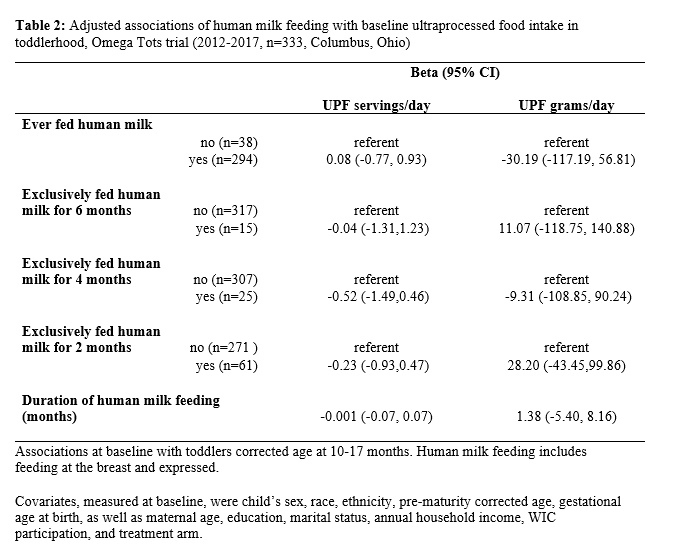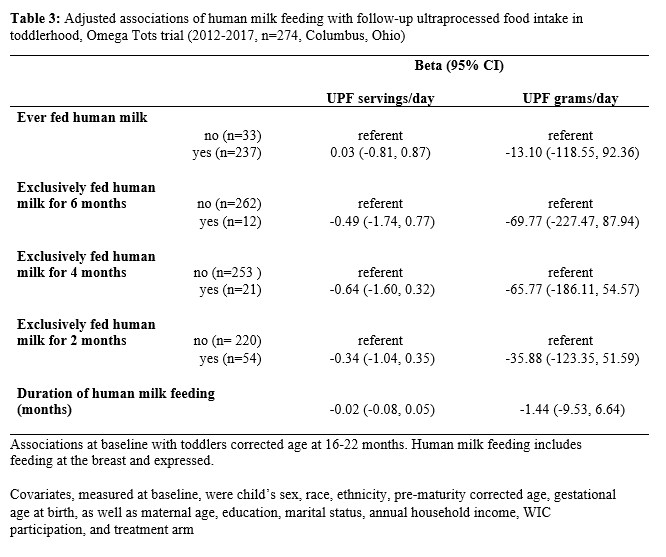Pediatric Nutrition
Pediatric Nutrition
45 - Early life human milk feeding and ultraprocessed food intake in preterm toddlers
Saturday, April 29, 2023
3:30 PM - 6:00 PM ET
Poster Number: 45
Publication Number: 45.253
Publication Number: 45.253
Samrawit F. Yisahak, Nationwide Children's Hospital, Columbus, OH, United States; Caroline Racke, Nationwide Children's Hospital, Columbus, OH, United States; Karolina M. Edlund, Nationwide Children's Hospital, Columbus, OH, United States; Sarah Keim, Nationwide Children's Hospital, Columbus, OH, United States
- SY
Samrawit F. Yisahak, PhD (she/her/hers)
Research Scientist
Nationwide Children's Hospital
Columbus, Ohio, United States
Presenting Author(s)
Background: Early life human milk feeding (at the breast or expressed) is thought to promote healthier diets in childhood by exposing infants to diverse flavors which later influence their acceptance of similar stimuli, and by promoting feeding styles responsive to infant cues which enhance self-regulation of intake. Ultraprocessed food (UPF)s are linked to greater adiposity and adverse lipid profiles in pediatric populations. Few studies have examined early feeding exposures in relation to UPF intake in toddlerhood, particularly among those born preterm who face barriers to breastfeeding.
Objective: In a secondary analysis of a fatty acid supplementation trial in toddlers born preterm, we evaluated the association of early life feeding with UPF intake across toddlerhood.
Design/Methods: Children born at < 35 weeks’ gestation were randomized at baseline (10-17 months’ corrected age) and followed up after 180 days (16-22 months’ corrected age). Caregivers had discontinued feeding human milk or formula before enrolling, and toddlers’ early life feeding was reported by questionnaire at baseline. We determined if toddlers ever received human milk, the duration of human milk feeding, and whether or not they had exclusive human milk feeding to 2, 4, and 6 months. Caregivers reported the child’s past month diet in a food frequency questionnaire at baseline and follow-up. We identified dietary UPF items using NOVA classification, and calculated UPF intake as servings/day and grams/day. We used linear regression to assess associations in 333 toddlers at baseline and 274 at follow-up. Covariates were child’s sex, race, ethnicity, corrected age, gestational age, maternal age, education, marital status, household income, WIC participation, and treatment arm.
Results: Nearly 89% (n=294) of 333 toddlers had ever received human milk, but only 18% (n=61), 8% (n=25), and 5% (n=15) were exclusively fed human milk to 2, 4, and 6 months, respectively. See sample characteristics by exposure to human milk in Table 1. Mean (SD) of UPF intake at baseline was 4.4 (2.4) servings/day or 333.8 (249.8) grams/day. At follow-up, it was 4.9 (2.1) servings/day or 374.3 (277.9) grams/day. There were no statistically-significant associations of aspects of human milk feeding with UPF intake at baseline (Table 2) or follow-up (Table 3).
Conclusion(s): Early life human milk feeding was not associated with toddlerhood UPF intake. If replicated, these results may reassure caregivers of preterm infants whose early feeding decisions may be influenced by the infant’s medical needs despite caregivers’ desire to feed human milk to promote long-term health.
.png)


